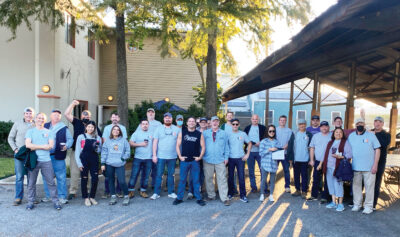Editor’s note: Sources in the transportation industry who handle various aspects of shipping North American wood products around the world shared their insights into how business went in 2020 and what we can expect in 2021.

Curtis Struyk
TMX Shipping Co. Inc.
Morehead City, NC
In the first half of 2020, we experienced blank sailings and canceled bookings which lasted longer than expected. The result of the blank sailings was less capacity which made it harder to secure vessel space. This caused three times the work to get the same result. We had to make a lot of advanced bookings to handle our customers’ demand only to see these canceled by the ocean carrier the week before the vessel was to sail. By the end of the 3rd quarter, U.S. imports were at a record high, which reduced export ocean freight rates in an effort to reposition equipment for higher paying freight coming back to North America. While reduced rates are attractive, the increase in import demand has caused a bottleneck at some major ports, and equipment is proving difficult to find. We are hopeful the equipment issue is remedied once import demand levels off in February of 2021.
Rates remained at historic lows during most of the 4th quarter, but we do not expect this to continue into 2021. Almost all ocean carriers have announced 1st quarter rate increases in the range of $200 to $300 per container, and we expect to see this continue through the 1st quarter.
Overall, we saw a 10 percent increase in export shipments in 2020 as compared to 2019. Much of this can be attributed to a rise in softwood and Hardwood log exports as lumber shipments were still down around 9 percent in 2020.
We are still seeing a high demand for exports; however, it is a challenge to find space and equipment, making it increasingly difficult to meet the current demand.
It will be interesting to see what effect the new administration and COVID-19 vaccine have on the U.S. economy in the coming months. Many are predicting a slow start to 2021 but are optimistic that the economy will rebound in the second half of the year.

Lloyd Lovett
King City/Northway Forwarding Ltd.
Montreal, QC
I really don’t like being the bearer of bad news, but 2020 came to a close with freight rates bouncing off all four walls, vessels being delayed, bookings getting rolled, port congestion, equipment shortage, COVID-19, container rates with 15-day expiration and, last but not least, the lack of service with some Vessel Ocean Carriers (VOC’s). As your newly elected President would say, “C’mon man, what the heck’s going on?”
I’ll do my best to explain the current situation.
King City is in communication, on a daily basis, with practically all the VOC’s, so when we started to have some serious issues (as mentioned above), I picked up the phone and started contacting the vice presidents to get their opinions on some of this chaos that we’re dealing with on a daily basis.
The consensus was that the vessel capacity and container demand was estimated to increase on average 3.5 percent for 2020. The actual first three quarters of 2020 saw an average increase of 6 percent, which started to put a little pressure on the shipping industry. In the latter stages of the 4th quarter, both container demand and vessel capacity increased up to 20 percent. This was due to the substantial increase in volume of manufactured goods being shipped from China to North America.
The VOC’s main objective was to have the container back to China where the demand is through the roof, along with the cost. For example, from Shanghai to Los Angeles, rates have been as high as $8,000/40′. In the first three quarters of 2020, that same container move would have been less than half that amount. Rumor has it that some companies are paying up to $1,000/40′ to have the box shipped empty from a USA port to Shanghai, just to secure a container for the Chinese exporter. I’m really hoping this is only a rumor, because this mindset will have serious consequences for our industry.
The other bone of contention that came up in a few of my conversations was the free time, which, in some cases, is as high as 28 days with the average being 21 days. Ten years ago, from New York to Shanghai, the ocean freight was approximately $1,200/40′ and the free time was seven days compared to the first three quarters of 2020, where the price was $250/40′ and free time was 21 days.
One would assume that the Coronavirus would have had a negative impact on imports from China. To the contrary, the last several months, due to COVID-19 restrictions, the demand for home renovations has exceeded all expectations. We all knew that the “To Do List” was going to come out sooner or later (mine was really soon). For many, it was landscaping, painting, renovations or replacing furniture (in/outdoors).
What lies ahead in 2021? The first quarter will mirror the last quarter of 2020. Logic would say that China was behind on their exports in the first two quarters of 2020 because of COVID-19. They made up for it in the last two quarters of 2020, which disrupted the already fragile container and vessel capacity. Coincidentally, this was the peak time for North American goods to be exported to China prior to the Chinese Lunar Year. Rates are going to increase while free time at destination will definitely decrease. On December 1, most VOC’s gave us rates valid until December 15, subject to General Rate Increase (GRI) as opposed to the usual 30-day validity.
In the past, these GRI’s would average $50 to $100, but currently, we foresee figures of $300 to $500. My humble advice to shippers would be to quote your clients a price for the lumber/logs Freight on Board (FOB) mill, subject to ocean freight at time of shipment. As much as it pains me to say it, VOC’s have the big bat, ball and glove. Like one vice president made very clear to me, don’t book 50 containers and use 25 because you’ll be considered an unreliable partner. I could translate that into my language, but I don’t think Paul or Terry Miller would be able to print it.
In closing, I wish to thank all my American and Canadian friends and companies that have supported King City throughout the years. I wish you all the best in health, happiness and prosperity for 2021.
My yearly quote is from Gary Keller: “Life is a question and how we live it is our answer.”

Stephen Zambo
Ally Global Logistics
Norwell, MA
The last two years have been anything but normal, 2020 especially so. As soon as industries figured out how to navigate tariffs and trade disputes, we were hit with a global pandemic. It’s a pandemic that we continue to fight. This is important for many reasons. In regard to the transportation industry, this is important because it is the beginning of the supply chain “breaking.” For years shippers have enjoyed low rates, relatively open vessels, container and chassis availability and a general lack of “challenges.”
Over the last four months, all of that has been flipped on its head. At the beginning of the pandemic steamship lines removed capacity from the market by instituting blank sailings. This is when a steamship line will remove a vessel from its rotation, thus trying to balance supply and demand. Little did the carriers know that the soft market we endured for the first five months of 2020 would begin to change mid- to late-summer and would take off like a rocket. That rocket ship has yet to come back to earth. It created many issues that we started to experience in December. Ally has contracts in place with every major steamship line, so we can always move cargo. It is a matter of the cost a shipper is willing to absorb.
Steamship lines make the majority of their money through their imports. Lumber and other heavy commodities are essentially used to reposition containers to Asia for steamship lines. For instance, a move from Shanghai to New York is 10 times the cost of a move from New York to Shanghai. Steamship lines have been moving empty containers overseas to capitalize on the increased import demand. They would rather move 10 empty containers weighing a total of 77,000 pounds with no revenue than one or two lumber containers weighing 60,000 pounds with little revenue. The quicker they can turn containers, the quicker they make money. It’s similar to a lumber operation. The quicker you can turn your kilns, the quicker you can make money.
Due to an excessive number of empties being exported, we’ve seen pressure on export rates, and in some areas container availability. The coastal ports have not endured these challenges as much as inland rails have, such as Columbus, Kansas City, St. Louis, Cincinnati, Nashville, Greer, Greensboro, etc. When equipment imbalances come into play, shippers are forced to absorb higher costs in order to move their product, thus pushing the freight rate market upward.
While we’ve endured space, rate and chassis related issues, one of the largest problems freight forwarders isolate shippers from is the steamship lines’ customer service. Carriers have been investing in technology which should be beneficial. However, we have seen them scale back their investment in people. Logistics is a complicated business that requires human interaction. We have had many challenges with steamship lines due to their lack of proper staffing and lack of knowledgeable staff.
We’ve run into a boatload of problems with our vendors that can negatively affect our clients. While we do what we can to shield our customers from steamship line related issues, it is not always possible. Over the last 30 years, I have never seen such poor service from our vendors.
While the shipping industry continues to endure its challenges, everything I hear and see points to a strong 2021 for the lumber industry as long as production can meet demand.
At Ally we’ve continued to focus on the export lumber market and have recently opened up a domestic transportation arm to handle domestic truckloads, flatbeds, and smaller shipments by the bundle(s). Given how the last few years have gone, I have faith that the lumber market will continue to improve. If the lumber market goes up, we at AGL will as well. We are fully invested in seeing this industry succeed.






